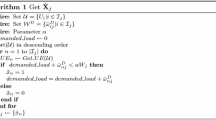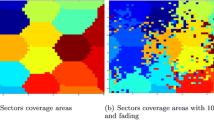Abstract
With advances in technology, network operators may need to set up a dynamic spectrum access overlay in heterogeneous networks (HetNets) to increase network coverage, spectrum efficiency, and the capacity of these networks. Uses of TV white space (TVWS) and long term evolution (LTE) are the combination of a new research direction to meet the increasing user demands in the domain of wireless cellular networks. Without the consideration of traffic flow, a network may operate with serious congestion problems that degrade the system performance. Congestion problems can be resolved by either reducing traffic flow or increasing the bandwidth provision. This paper has proposed Distributed dynamic load balancing (DDLB) cellular-based TVWS and LTE technique, such that a cellular-based device can operate on both TVWS and LTE by simply switching its frequency of operation when necessary. The objective of this paper is to resolve the congestion problems in a HetNet through dynamically constructing new clusters to increase the system bandwidth. The simulation results show that the proposed technique solved the bottleneck problem, reduced transmission control overhead and power consumption, and increased the average throughput and load balancing index.











Similar content being viewed by others
References
Mendes, L. D. P., & Rodrigues, J. J. P. C. (2011). A survey on cross-layer solutions for wireless sensor networks. Journal of Network and Computer Applications, 34, 523–534.
Whitaker, R. M., et al. (2005). The infrastructure efficiency of cellular wireless networks. Computer Networks, 48, 941–959.
Lai, W. K., & Tang, C.-L. (2013). QoS-aware downlink packet scheduling for LTE networks. Computer Networks, 57, 1689–1698.
Xenakis, D., et al. (2012). An energy-centric handover decision algorithm for the integrated LTE macrocell–femtocell network. Computer Communications, 35, 1684–1694.
Kawade, S., & Nekovee, M. (2011). Broadband wireless delivery using an inside-out TV white space network architecture. In Global telecommunications conference, 2011 IEEE, pp. 1–6.
Villardi, G. P., et al. (2012). TV white space technology: Interference in portable cognitive emergency network. Vehicular Technology Magazine, IEEE, 7, 47–53.
Gupta, A., et al. (2007). Decentralized key generation scheme for cellular-based heterogeneous wireless ad hoc networks. Journal of Parallel and Distributed Computing, 67, 981–991.
Cao, J., et al. (2012). A simple and robust handover authentication between HeNB and eNB in LTE networks. Computer Networks, 56, 2119–2131.
Han Nah, C., et al. (2012). An interference analysis for coexistence of femto-LTE in TV white space with various OOB level. In ICT convergence (ICTC), 2012 international conference on, pp. 137–138.
Balamurthi, R., et al. (2011). A TV white space spectrum sensing prototype. In New frontiers in dynamic spectrum access networks (DySPAN), 2011 IEEE symposium on, pp. 297–307.
Sang Yun, L., et al. (2010). Area spectrum efficiency of TV White space wireless system with transmit power control. In Advanced communication technology (ICACT), 2010 the 12th international conference on, pp. 1061–1066.
Koike-Akino, T., et al. (2009). Optimized constellations for two-way wireless relaying with physical network coding. Selected Areas in Communications, IEEE Journal on, 27, 773–787.
Tabrizi, H., et al. (2013). Tethering over TV white-space: Dynamic hotspot selection and resource allocation. In IEEE vehicular technology conference, Las Vegas, Nevada.
Sasikumar, P., & Khara, S. (2012). K-means clustering in wireless sensor networks. In Computational intelligence and communication networks (CICN), 2012 fourth international conference on, pp. 140–144.
Liansheng, T., et al. (2008). A balanced parallel clustering protocol for wireless sensor networks using K-means techniques. In Sensor technologies and applications, 2008. SENSORCOMM ‘08. second international conference on, pp. 300–305.
Hassanein, H., et al. (2005). Infrastructure-based MAC in wireless mobile ad-hoc networks. Ad Hoc Networks, 3, 717–743.
Xiao Hui, L., et al. (2009). A clustering algorithm based on K-means for wireless indoor monitoring system. In Information technology and computer science, 2009. ITCS 2009. International conference on, pp. 488–492.
Arthur, D., & Vassilvitskii, S. (2007). K-means++: The advantages of careful seeding. Presented at the ACM-SIAM symposium on Dicrete algorithms, 2007.
Bradley, P., et al. Constrained K-means clustering. In Technical report MSR-TR-2000-65. Microsoft Research, Redmond, WA.
Murty, R., et al. (2012). SenseLess: A database-driven white spaces network. Mobile Computing, IEEE Transactions on, 11, 189–203.
Hui, X., et al. (2009). K-means clustering versus validation measures: A data-distribution perspective. Systems, Man, and Cybernetics, Part B: Cybernetics, IEEE Transactions on, 39, 318–331.
Liu, D., et al. (2012). Research on cooperative user relaying assisted load balance scheme in OFDMA networks. Procedia Engineering, 29, 3799–3807.
Tabrizi, H., et al. (2013). Coordinated tethering over white-spaces. In IEEE transactions on vehicular technology, pp. 1–10.
Akkari, N., et al. (2014). Dynamic clustering protocol for coordinated tethering over cellular networks. Journal of Network and Computer Applications, 42, 92–101.
Akkari, N., et al. (2013). Coordinated tethering over cellular networks: Handover scenarios and signaling. In Personal indoor and mobile radio communications (PIMRC), IEEE 24th international symposium on, pp. 2170–2174.
Khalifah, A., et al. (2014). Dense areas femtocell deployment: Access types and challenges. In The third international conference on e-technologies and networks for development.
The Network Simulator ns-2, http://www.isi.edu/nsnam/ns/ns-build.html, Jan 2011.
Acknowledgments
This paper was funded by the Deanship of Scientific Research (DSR), King Abdulaziz University, under Grant No. (11-15- 1432 HiCi). The author, therefore, acknowledge with thanks DSR technical and financial support. The authors would like to thank Prof. John Cioffi and Haleh Tabrizi from Stanford University, due to their research collaboration, and constructive comments that improved this research work.
Author information
Authors and Affiliations
Corresponding author
Rights and permissions
About this article
Cite this article
Aldabbagh, G., Bakhsh, S.T., Akkari, N. et al. Distributed dynamic load balancing in a heterogeneous network using LTE and TV white spaces. Wireless Netw 21, 2413–2424 (2015). https://doi.org/10.1007/s11276-015-0921-4
Published:
Issue Date:
DOI: https://doi.org/10.1007/s11276-015-0921-4




